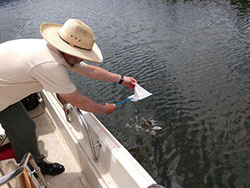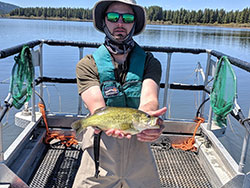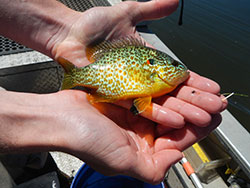
Paul Divine, Lassen County district fisheries biologist for CDFW, releases Largemouth Bass fry into Mountain Meadows Reservoir in 2018 as part of the effort to rebuild a trophy bass fishery that existed before the reservoir went dry in 2015.

Former CDFW Scientific Aid Joshua Faughn holds up a chunky Largemouth Bass that turned up in one of CDFW’s electrofishing surveys of Mountain Meadows Reservoir. CDFW has electrofished the reservoir five times since water returned following the 2015 drought.

Pumpkinseed Sunfish have recolonized Mountain Meadows Reservoir on their own. Biologists believe they survived the drought and the reservoir going completely dry by holding out in one of the reservoir’s creek arms.
Monty Currier’s heart sank when an excited angler told him recently of catching trophy-sized crappie at Mountain Meadows Reservoir in Lassen County.
For the past five years, Currier, a California Department of Fish and Wildlife (CDFW) environmental scientist assigned to reservoir fisheries in the north state, has been working to rebuild the fishery at Mountain Meadows Reservoir after the Pacific Gas and Electric (PG&E) impoundment went dry in 2015 from the combined effects of maintenance work and the drought. Crappie were not part of the restoration plan.
Currier’s spirits lifted when the angler pulled out his phone. The photos he proudly showed off were not of crappie – but rather of good-sized Sacramento Perch, California’s only native sunfish and the result of CDFW transplants from Biscar Reservoir in Lassen County, Lake Almanor in Plumas County and Clear Lake Reservoir in Modoc County.
Anecdotal progress reports such as these have had to sustain Currier of late along with his CDFW colleagues Paul Divine, a district fisheries biologist for Lassen County, and Amber Mouser, who oversees fisheries issues in Plumas County and has worked closely on the Mountain Meadows Reservoir restoration. Plans to formally survey and electrofish Mountain Meadows Reservoir this past spring and next fall have been postponed as a result of COVID-19-related social distancing mandates preventing the work, which typically requires three people working in close proximity aboard an electrofishing boat.
The unfortunate 2015 fish kill at Mountain Meadows Reservoir presented Currier with something of a dream opportunity.
“It’s pretty special because you don’t often get the chance to start from scratch and build up a fishery,” he said. “It takes a lot of diligence, multiple agencies and groups working together to make things happen. There are a lot of moving parts.”
In addition to Sacramento Perch, stocking largemouth bass and seasonal rainbow trout have also been part of the restoration efforts. But before any fish were introduced, CDFW added 600 fish habitat structures in 2016 consisting of brush piles and recycled Christmas trees to jump-start the habitat.
Although Mountain Meadows Reservoir today brims with 5,800 acres surface feet of water, the lake is shallow – at no more than 15 or 16 feet at its deepest point – and heavily vegetated. It offers good habitat to support a self-sustaining largemouth bass fishery and a put-and-take recreational trout fishery in cold weather months. Prior to going dry in 2015, the reservoir offered a trophy largemouth bass fishery and hosted several tournaments and other fishing contests each year.
Rebuilding the popular largemouth bass fishery began in earnest in 2017 with captured bass transplanted from Antelope Lake in Plumas County. In 2018, 2,000 fingerling largemouth bass were purchased from a private hatchery and stocked through the combined efforts of PG&E, the Mountain Meadows Conservancy, local anglers and community sponsors. Last year, largemouth bass were transplanted from Biscar Reservoir. Currier works with CDFW fish pathologists to ensure that the fish are disease-free and safe to translocate.
A spring electrofishing survey would have provided insight on how many bass were now spawning in Mountain Meadows Reservoir. A fall survey would reveal how successful the spring spawning had been.
The last time CDFW had a chance to monitor the recovery was in August of 2019 when two electrofishing boats sampled the western portion of the reservoir. The results were encouraging: 718 fish were captured, the highest catch overall compared to the four previous electrofishing surveys since the reservoir was rewatered.
Fifty-six largemouth bass were captured last August, many being juveniles indicating natural spawning was occurring. Twenty-four Sacramento perch turned up – compared to just three of the fish captured in two previous surveys combined earlier in the year, though well below the 80 Sacramento perch captured in 2018.
The most plentiful species of sport fish in the August 2019 survey was the pumpkinseed sunfish at 417. The pumpkinseed sunfish fishery is very popular at the reservoir, said Currier, and appears to be recovering without the aid of stocking or transplants from CDFW. Currier said the fish likely repopulated the reservoir from one of the creeks that feeds into it.
Currier and CDFW biologists are particularly interested to see whether the pumpkinseed sunfish and Sacramento perch can co-exist over time. Native Sacramento perch, which evolved in the Sacramento-San Joaquin Delta prior to the introduction of non-native sunfish and other predatory species from the Midwest and East Coast, have trouble competing for food and habitat with more aggressive, non-native sunfish such as the pumpkinseed and crappie.
Sacramento perch are an otherwise hardy and adaptable sport fish appreciated by anglers for their fine table fare. CDFW fisheries biologists are constantly on the lookout for suitable waters to expand their range, expose them to more anglers and ensure the species genetic diversity and survival.
Overall, pumpkinseed sunfish accounted for 64 percent of the electrofishing catch in Mountain Meadows Reservoir from 2017 to 2019 compared to Sacramento perch that represented just 7.6 percent of the sampled fish. Three 2019 electrofishing surveys resulted in lower Sacramento perch numbers than in 2018, but CDFW scientists such as Currier note that Sacramento perch can be difficult to electrofish and net due to their dark coloration that makes them difficult to see and their tendency to hold in heavy cover. Other factors such as different water temperatures at the time of the surveys could explain some of the drop-off in Sacramento perch numbers from 2018.
One hundred forty-three Sacramento perch were translocated to Mountain Meadows Reservoir from Biscar Reservoir as recently as June 2019 in an attempt to boost the breeding stock. That anglers are now catching Sacramento perch worth bragging about – even if they are sometimes mistaken as black crappie – is something Currier and his colleagues can take pride in for now.
###
CDFW Photos. Top Photo: CDFW Environmental Scientist Monty Currier proudly shows off a Mountain Meadows Sacramento Perch, which CDFW introduced into the reservoir to provide an exciting sport fishery for local anglers.
Media Contact:
Peter Tira, CDFW Communications, (916) 215-3858.